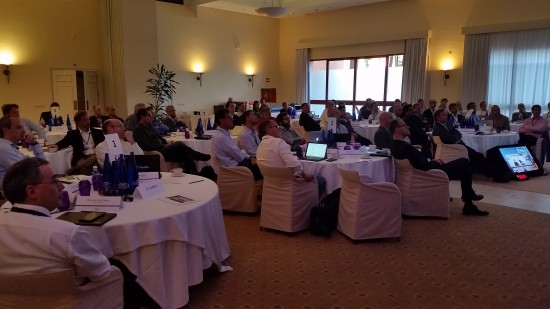































Digital disruption.IDC says that 40% of market share leaders in their respective industries (our customers!) will be out of business in 10 years, because they will miss their transformation to Digital. What they need?Fast IT. Cisco experienced (both first hand and with our customers) that Fast IT is the key capability that enterprises need to build to successfully transition to a digital model. Over the last 8 years, Cisco has built a truly unique approach to Fast IT, grounded on our own internal IT transformation, which led (among others) to the Cisco eStore. We learnt that adopting a Fast IT model is less about technology and more about progressive cultural and process changes. The transition requires pervasive shifts in the way IT is organised; how services are defined, delivered, consumed, and financed; and how IT measures success, evaluates costs, and assigns roles and responsibilities.
This week, at the Partner Technical Advisory Board (PTAB), we have the pleasure of hosting around 40 Cisco Partner CTOs for three days in beautiful Marbella, Spain. The objective is to hear and gather their views and advice on the vision, strategy and deployment to market of Cisco technologies, products, architectures, services, and solutions. We are having a fruitful open exchange, ultimately helping us meet our mutual growth and profitability goals as we together deliver business outcomes to our customers.

On the agenda of the day 3: Cisco's approach toFast IT Business Transformation, and more specifically what is the opportunity for Cisco partners. To understand Cisco's core message for Fast IT, you can watch the following short video.
Here are 3 collaterals summarising our message:
Interested to know more? Read further.
"Consumer centricity (the consumer becomes the "hub") creates a need for organizations to think differently about their businesses - traditional silos are breaking down, and organizations and industries need to collaborate in new ways, 'intersected' by the digital consumer."
Seeding questions to Cisco partners:
1. How aware is your client of their need to drive their own digital transformation/disruption? Who might be sponsoring this effort inside the customer (e.g. CIO, CFO, COO, CMO, etc.)?
2. What are the main challenges facing your client's IT department to better meet the accelerating business needs of their enterprise? Is it more about technology, about processes, or about people/culture/organization of the IT department?
3. Moving forward, does the CIO intend to balance his/her role as "IT Provider", with another role as "IT Service Broker"? How are you, Cisco's partner, influencing this decision and positioning yourself as the trusted supplier of ITaaS offerings.
4. What are the main inhibitors for you, Cisco's partner, to lead an IT transformation engagement (cf. ITaaS Operating Model) at your strategic clients? What are the potential capabilities you are missing?
5. How are you helping your clients evolve their IT investment/financial strategy, ensuring the appropriate balance between flexibility, agility and risk? Do you consider the evolution to flexible IT consumption models either a threat or an opportunity for your own profitability and cash flow?
Still in doubt? Here are 3 quotes collected from CIOs in recent Fast IT engagements:
-"Your guidelines will be integrated in our management plan, we are very grateful to Cisco whohelped us transform our internal IT to better support the business."
-"I would like to thank you again for Strategic IT Roadmap Report and IT Value Map. Both documents areexcellent starting point for our Cloud strategyand great help for communication with local CIOs. I am looking forward topresent both documents to my minister."
-"You havestructured all the issues I had in mind for years, and now I have an actionable plan that I can work on. [...] I intend to place the IT Value Map in every meeting room of the IT department building!"
How to starta Fast IT Business Transformation engagement, jointly with Cisco?
-Engage your local Cisco partner account manager and/or contact [email protected] to identify the best client(s) to jointly work on.
-Engagements are typically Cisco-funded. The impact on client resources is minimal.
-Organize an executive briefing session (CIO-level) to position our value proposition.
-Get the list of 8 key stakeholders who we can interview. These stakeholders should be selected as those people "with an opinion" (managers and/or single contributors).
-The interviews (90 minutes each) are done 1:1, and typically take place over 3-4 days.
-Cisco's and its partner's architects will deliver the final report after 3 weeks.
 Tags quentes :
Transformação Digital
digital disruption
Fast IT
Tags quentes :
Transformação Digital
digital disruption
Fast IT